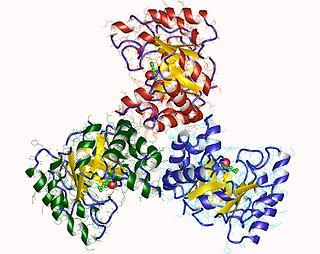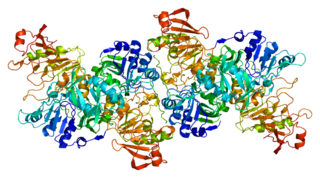In enzymology, a citrate CoA-transferase is an enzyme that catalyzes the following chemical reaction:
In enzymology, a succinate-citramalate CoA-transferase is an enzyme that catalyzes the chemical reaction
The enzyme citramalate lyase catalyzes the chemical reaction
The enzyme citramalyl-CoA lyase catalyzes the chemical reaction

The enzyme citrate (pro-3S)-lyase catalyzes the chemical reaction
The enzyme citryl-CoA lyase catalyzes the chemical reaction
In enzymology, a [citrate (pro-3S)-lyase] ligase is an enzyme that catalyzes the chemical reaction
The enzyme citrate lyase deacetylase (EC 3.1.2.16) catalyzes the reaction
In enzymology, a deacetyl-[citrate-(pro-3S)-lyase] S-acetyltransferase (EC 2.3.1.49) is an enzyme that catalyzes the chemical reaction
In enzymology, formate C-acetyltransferase is an enzyme. Pyruvate formate lyase is found in Escherichia coli and other organisms. It helps regulate anaerobic glucose metabolism. Using radical non-redox chemistry, it catalyzes the reversible conversion of pyruvate and coenzyme-A into formate and acetyl-CoA. The reaction occurs as follows:

In enzymology, a homocitrate synthase (EC 2.3.3.14) is an enzyme that catalyzes the chemical reaction

In enzymology, a malate synthase (EC 2.3.3.9) is an enzyme that catalyzes the chemical reaction
In enzymology, a beta-pyrazolylalanine synthase (EC 2.5.1.51) is an enzyme that catalyzes the chemical reaction
In enzymology, a cysteine synthase is an enzyme that catalyzes the chemical reaction
In enzymology, a L-mimosine synthase (EC 2.5.1.52) is an enzyme that catalyzes the chemical reaction
In enzymology, an O-acetylhomoserine aminocarboxypropyltransferase is an enzyme that catalyzes the chemical reaction
In enzymology, an uracilylalanine synthase (EC 2.5.1.53) is an enzyme that catalyzes the chemical reaction

In molecular biology, the citrate synthase family of proteins includes the enzymes citrate synthase EC 2.3.3.1, and the related enzymes 2-methylcitrate synthase EC 2.3.3.5 and ATP citrate lyase EC 2.3.3.8.
Acetyl-S-ACP:malonate ACP transferase is an enzyme with systematic name acetyl-(acyl-carrier-protein):malonate S-(acyl-carrier-protein)transferase. This enzyme catalyses the following chemical reaction

Coenzyme A transferases (CoA-transferases) are transferase enzymes that catalyze the transfer of a coenzyme A group from an acyl-CoA donor to a carboxylic acid acceptor. Among other roles, they are responsible for transfer of CoA groups during fermentation and metabolism of ketone bodies. These enzymes are found in all three domains of life.





